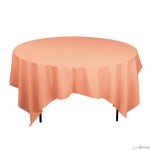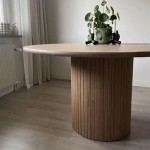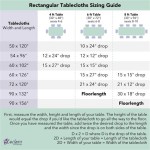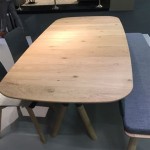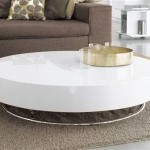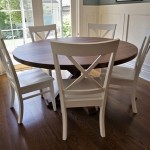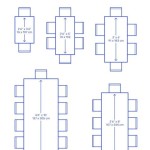How to Fold a Banquet Table: A Step-by-Step Guide
Banquet tables are ubiquitous in event spaces, conference centers, and even residential settings where temporary, large-surface dining or display arrangements are needed. Their versatility and foldability make them ideal for storage and transport. Properly folding a banquet table is crucial not only for efficient storage but also for preventing damage and ensuring its longevity. This article provides a detailed, step-by-step guide on how to safely and effectively fold a banquet table.
Understanding Banquet Table Construction
Before attempting to fold a banquet table, it's beneficial to understand its basic construction. Most banquet tables consist of a tabletop, typically made of wood, plastic, or laminate, and a folding leg mechanism. This mechanism usually involves hinges, locking mechanisms, and support braces designed to collapse and secure the legs against the underside of the tabletop. The specific design of these mechanisms can vary slightly between manufacturers and models, but the underlying principles remain consistent. Familiarizing oneself with the table's specific features will facilitate the folding process and minimize the risk of damage.
Common materials used for the tabletop include plywood covered with a vinyl or laminate surface, high-density polyethylene (HDPE) plastic, or resin. The legs are typically constructed of steel tubing, often coated with a protective finish such as powder coating to prevent rust and corrosion. The hinges and locking mechanisms are usually made of steel or aluminum, designed for durability and repeated use. Understanding the materials used in the table's construction will inform the level of care needed during the folding process.
The weight capacity of a banquet table is another important factor to consider. While folding the table, ensuring that it is free of excessive weight will prevent undue stress on the folding mechanism and the tabletop. Overloading the table, even during the folding process, can lead to warping, bending, or even breakage. Checking the manufacturer's specifications for weight limits is a good practice, especially if the table has been used to support heavy items.
Step-by-Step Folding Instructions
The following steps provide a general guide for folding a banquet table. However, always refer to the manufacturer’s instructions, if available, as specific models may have unique features or requirements.
Step 1: Clear the Table Surface. Remove all items from the tabletop. This includes dishes, decorations, linens, and any other objects that might interfere with the folding process or be damaged in the process. A clear, unobstructed surface is essential for safe and efficient folding. Pay attention to any spills or debris on the table; cleaning the surface before folding will prevent these from being trapped between surfaces or causing damage.
Step 2: Locate and Disengage the Leg Locking Mechanisms. Most banquet tables have locking mechanisms that secure the legs in the open position. These mechanisms can take various forms, including levers, buttons, pins, or spring-loaded catches. Typically, these mechanisms are found near the point where the legs attach to the underside of the tabletop. Carefully examine each leg to identify the locking mechanism. To disengage the legs, one may need to press a button, slide a lever, or pull a pin. The specific action required will depend on the table's design. Ensure that all locking mechanisms for each leg are disengaged before proceeding. Failure to properly disengage these mechanisms can result in damage to the table or injury to the person attempting to fold it.
Step 3: Fold the Legs Inward. With the locking mechanisms disengaged, gently fold the legs inward towards the center of the table. The legs should pivot on their hinges, moving from a vertical position to a horizontal position against the underside of the tabletop. Support the weight of the legs as they are being folded to prevent them from slamming against the tabletop, which could cause damage. If the legs are stiff or difficult to move, double-check that the locking mechanisms are fully disengaged. Applying excessive force can damage the hinges or other components. If resistance persists, consider applying a small amount of lubricant to the hinges to ease movement, but only after confirming that the locking mechanism is indeed fully disengaged.
Step 4: Secure the Legs in the Folded Position. Many banquet tables have a secondary locking mechanism or a latch that secures the legs in the folded position. This mechanism prevents the legs from unfolding accidentally during storage or transport. This might be a hook and loop strap, a clip, or a built-in locking device. Ensure that the legs are properly secured before moving or storing the table. If the securing mechanism is damaged or missing, consider using a strap or rope to bind the legs together for added safety. This will prevent the table from unfolding unexpectedly and potentially causing injury or damage.
Step 5: Check for Stability and Proper Closure. Once the legs are folded and secured, inspect the table to ensure that it is stable and that all components are properly aligned. Check that the legs are flush against the underside of the tabletop and that there are no protruding parts that could be damaged during storage or transport. If the table feels unstable or if any components are misaligned, re-examine the folding process to identify and correct any issues. Minor adjustments might be necessary to ensure a secure and stable folded configuration.
Proper Storage and Maintenance
Proper storage and maintenance are crucial for extending the lifespan of banquet tables. Following these guidelines will help prevent damage and ensure that the tables remain in good condition for years to come.
Selecting a Suitable Storage Location: Choose a storage location that is dry, clean, and protected from extreme temperatures and humidity. Damp environments can promote rust and corrosion on metal components, while extreme temperatures can cause warping or cracking of the tabletop. Avoid storing tables in direct sunlight, as prolonged exposure can fade or damage the finish. Opt for a location that is easily accessible but also protected from accidental bumps or impacts that could damage the tables.
Stacking and Protecting Tables: When stacking banquet tables, use protective padding or blankets between the tabletops to prevent scratches and abrasions. Ensure that the tables are stacked evenly and securely to prevent them from tipping over. Avoid stacking too many tables on top of each other, as this could place excessive stress on the lower tables. If possible, store tables upright on their sides, as this can save space and reduce the risk of damage. Consider using table carts or dollies for transporting tables, as these will minimize the risk of damage and make it easier to move multiple tables at once.
Regular Cleaning and Inspection: Regularly clean the tabletops and legs with a mild detergent and water to remove dirt and debris. Avoid using harsh chemicals or abrasive cleaners, as these can damage the finish. Inspect the tables periodically for signs of damage, such as loose hinges, cracked tabletops, or rusted legs. Address any issues promptly to prevent them from worsening. Lubricate the hinges and locking mechanisms periodically with a silicone-based lubricant to keep them functioning smoothly. Repair or replace any damaged components as needed to maintain the table's structural integrity.
Preventative Measures: Consider using table covers or linens to protect the tabletops from scratches, spills, and other damage during use. Avoid placing hot items directly on the tabletops, as this could cause heat damage. Use coasters or placemats to protect the surfaces from stains and water rings. Encourage careful handling of the tables to prevent accidents and damage. By taking these preventative measures, the lifespan of the banquet tables can be significantly extended, saving time and money in the long run.
By understanding the construction, following the correct folding procedures, and adhering to proper storage and maintenance practices, one can ensure that banquet tables remain functional and aesthetically pleasing for many events to come. While this guide provides general information, always refer to the manufacturer's specific instructions for the table model in question.

Black Rectangular Folding Banquet Table At Rs 6500 In Mumbai Id 24616640033

48 Round Banquet Folding Table The Chiavari Chair Company

Banquet Table Fold In Half 6 X 2 5 Plastic
Furnimall Banquet Table Folding Catering Hall Buffet Outdoor Dining Meja Lipat Niaga Ee Malaysia

Plastic Development Group 816 Fold In Half 8 Foot Folding Banquet Table White 1 Piece Pay Less Super Markets

How Many People Fit At A Banquet Table Webstaurant

Plastic Development Group 6 Ft Indoor Outdoor Folding Banquet Table Black Com

30x72 Wood Fold Table Yt T30x72 Tbl Folding Chairs 4 Less

24x48 Mel Wood Fold Table Yt 2448 Bizchair

Lifetime 72 In White Plastic Portable Fold Half Folding Banquet Table 25011 The Home Depot
Related Posts


